
UK OPSM - Introducing PlayStation Yaroze
January 19, 2021, at 03:47 AM (1 comments)
Title: UK OPSM - Introducing PlayStation Yaroze Author: mgarcia Date: 2021-01-19 03:47 +0100 Tags: Media, Articles Comments: Open
|  |
Official UK PlayStation Magazine issue 17 March 1997, Page 68.
Introducing PlayStation Yaroze.
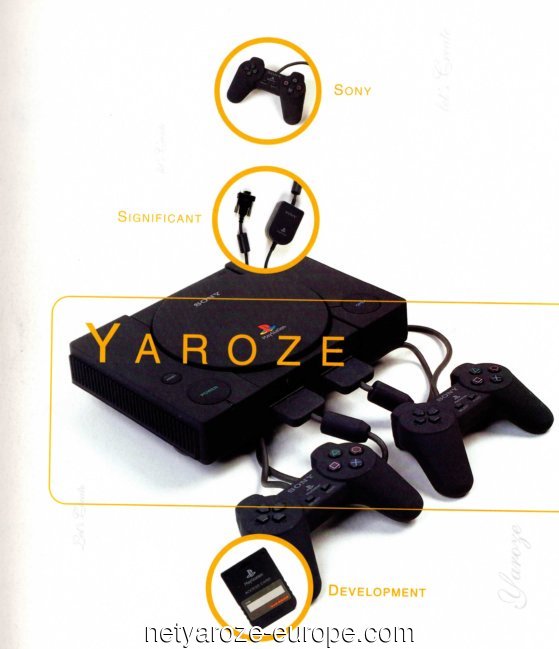
On February 28th (1997), Sony will launch what could be one of the most significant products to hit the UK games market for years. But this isn't a new super-console, or a new 3D graphics chip, or even a mold-breaking software title: It is their home development kit, Yaroze, And if things go to plan it could bump the industry out of a rut it's been ploughing for some time - Black magic.
Yaroze's aim is to re-ignite the back-bedroom programming scene that peaked with the Amiga and started way back in the days of the venerable Sinclair ZX-80. Every school and college contains a few computer nerds, but for a brief time during that period they became nerds with Ferraris, as the UK software industry mined an incredibly rich seam of talent.
In bedrooms all over the land, people fiddled with code until the wee hours of the morning, pushing the envelope of what the systems they were working on could achieve, and making sure that gaming was kept in an almost permanent state of revolution. Sure, many of the results were agonisingly bad, but don't forget that people like Sid Meier started here, and among the dross were sewn the seeds of future stellar careers.
Since then, though, things-have changed drastically. The computer game market went from underground to overground with a rush and started solidifying into its current form, dominated by large companies with suitably huge budgets. The consoles arrived, which effectively locked the hobbyist out, and the PC became increasingly complex to code for as it evolved spasmodically into today's multimedia machine. In. short, apart from a few hardened shareware enthusiasts, the back-bedroom programming scene first got suffocated and then died.
It's easy to underestimate the importance of all this, and it's probably not until you talk to someone like Bullfrog's Peter Molyneux that the full impact of the decline of home programming becomes clear. 'It's a bigger long-time impact than people realise', he says. 'The reason why Britain is accredited with so much games design - some people bandy around figures that one-third of all programmes written have British influence in them - is not because we're a fantastically creative nation. It's because we had more home computers than everyone else and they were cheap enough for everybody to-use.'
In relative terms, Yaroze is cheap too. £549 might sound like a considerable amount of money but compare that to the full-blown PlayStation development kit, which comes in at around the £10,000 mark, and we're talking serious bargain.
Okay, so-you need to have either a PC or a Mac as well - though luckily as the PlayStation does most of the work, these can be quite low-specced machines - which bumps up the overall cost a bit. But apart from that, the Yaroze package contains everything you need to start coding (see below).
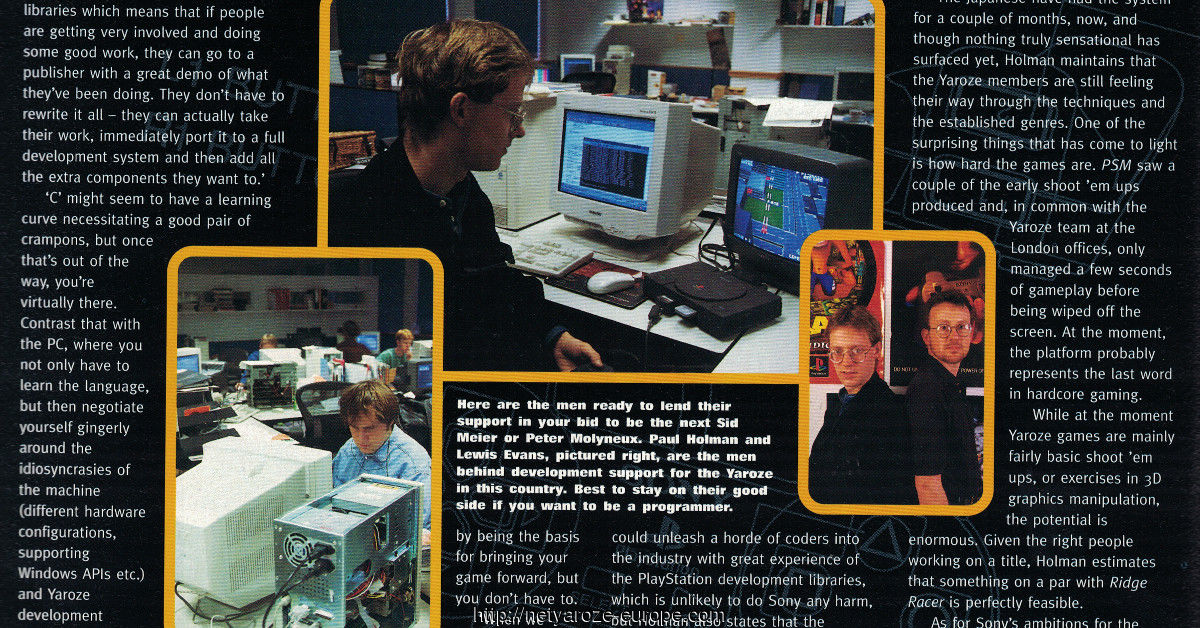
Here are the men ready to lend their support in your bid to be the next Sid Meier or Peter Molyneux. Paul Holman and Lewis Evans, pictured right, are the men behind development support for the Yaroze in this country. Best to stay on their good side if you want to be a programmer.
'If you contrast the-development kit with Yaroze we've tried to go fora much-more straightforward approach, whereby we've based everything around using the PlayStation itself for development,' says Paul Holman, SCEE's development support manager. 'The downside of that is that firstly you're constrained by the amount of memory you have in the PlayStation.
For development systems we provide 8MB of memory on a board, whereas you only have 2MB of main memory for program space on the Yaroze system. In addition the restrictions are that you can't really make use of the CD-drive. We provide a disc which has got some models that you can access, but in general it's not designed for CD. One of the reasons we did this is because you have to consider why people use CD. Either they're creating some enormous game, ог they're creating things with lots of FMV sequences and thought that wasn't really necessary. The goal was to provide PlayStation development for as many people as possible by making the cheapest solution possible.'
There are a couple of important things to note here, the first one probably being memory. Any game written for Yaroze is going to have to fit inside 3.5MB (2MB main RAM, 1MB VRAM and 512k sound RAM) which, in the current CD-based games climate, seems rather like trying to cram a very large genie back into an extremely cramp bottle. According to Holman, though, it's not as bad as it sounds: 'If you think about it, when people write for the PlayStation, anyway, they have the same limits - all you're talking about is the depth of the game. If you take a title like Tomb Raider, it loads up almost a complete level in one go and then doesn't access the disc other then to stream off some music now and again for a level. Sure, you couldn't create the whole of Tomb Raider, but you could go as far as creating one level'.
Hopefully this will lead the focus of Yaroze development along the path of developing gameplay rather than people trying to create endless pre-rendered sequences to mask the fact that their game is, in fact, a bit cack. Not that the mainstream software industry has been doing that for years - of course not.
The other point is that the CD-drive is, for all intents and purposes, disabled. This is where the new back-bedroom model differs wildly from the original one. Then, games were produced and often marketed directly from the place where they were written. With Yaroze, nobody's going to be able to burn their own discs and start flogging them on the open market - especially as Yaroze code will only work on Yaroze players.
Another thing worth pointing out to anyone thinking of investing in Yaroze is that you're going to be programming in 'C. For all those people with no programming experience, we've taken part of Sony's sample code for a simple Breakout-style game and gone through it to show you what you're letting yourself in for (see page 73).
Anybody now developing headaches probably won't be comforted by the fact that according to Lewis Evans, one of the developer support engineers working on the Yaroze project, you're probably talking a. whole university term to learn it from scratch. That said, though, he adds: 'C is a completely reasonable language to learn. It has to be said that there are languages easier to program in, but the vast majority of them tend to be interpreted languages which means that they run slower. C is so popular because it runs so fast. People can learn it off their own back - there are loads of books on how to learn C which are quite good, these days, plus there's endless reference and help simply because it's so popular'.
'You can certainly put together some simple stuff very quickly,' says Holman. 'The advantage of using the PlayStation libraries is that the nitty-gritty hard work has already been done for you, in terms of creating a 3D world. So if you had any sort of programming background at all, or maybe just played with BASIC a few years ago, you won't find it that hard to get into C.'
Intimidating to the novice though it is, going for "C" rather than the simpler BASIC (which is going to be at the core of Sega's forthcoming home-development system) was a deliberate decision on the part of the Yaroze team.
'Our view was that we wanted to allow people to have a grown-up development system at home,' Holman continues. 'The libraries it uses аге taken from the main developer libraries which means that if people are getting very involved and doing some good work, they can go to a publisher with a great demo of what they've been doing. They don't have to rewrite it all - they can actually take their work, immediately port it to a full development system and then add all the extra components they want to.'
"C" might seem to have a learning curve necessitating a good pair of crampons, but once that's out of the way, you're virtually there.
Contrast that with the PC, where you not only have to learn the language, but then negotiate yourself gingerly around the idiosyncrasies of the machine (different hardware configurations, supporting Windows APIs etc.) and Yaroze development seems relatively straightforward.
'Again the advantage of using the PlayStation as a platform for games development is that if you were trying to create a game for the PC, in addition to learning the language itself you have to code for every possible permutation of the PC, whereas the PlayStation is much simpler. You've got a very well-defined interface, and a proven interface in that the libraries have been used for several years. And I think it's relatively straightforward if you have the inclination for it.'
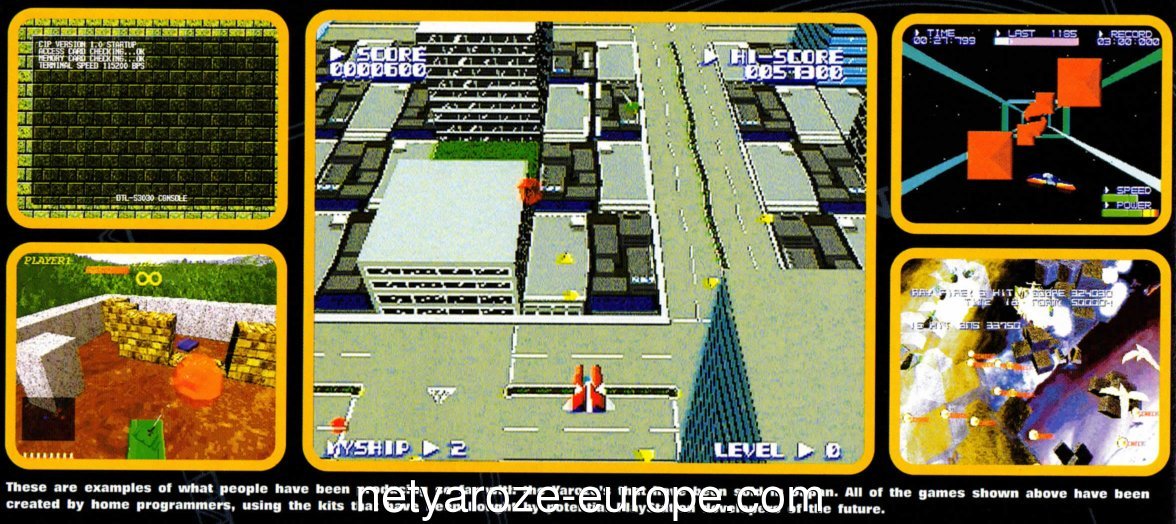
These are examples of what people have been producing so far with the Yaroze's that have been sold in Japan. All of the games shown above have been created by home programmers, using the kits that have been bought by potential PlayStation developers of the future.
In a surprise move to many people, Sony haven't slapped any copyright agreements on Yaroze. Essentially, once something's been written, it's up to the coder to decide what to do with it.
'It's your copyright, it's your code,' comments Holman. 'As far as Sony are concerned we'd love you to come to us, and we'll help as much as possible by being the basis for bringing your game forward, but you don't have to. When we announced this at the Develop Conference, a number of publishers asked if we were going to keep the site to ourselves and our members. It's an open site. There are no restrictions on the thing at all, and so if somebody at EA or Virgin also wants to become a member and look at what people have done, there's nothing to stop them.'
Naturally, Sony aren't releasing details of their enrolled members, but the development community is keenly interested in the whole project. On the one hand they can scout upcoming talent and on the other they've suddenly got rather cheap kits that they can give to any member of their staff who wants one (not easy when the current kit is 10 grand a pop). What, though, do Sony get out of the whole thing? Is this really just an exercise in corporate philanthropy? Well, to an extent yes.
Okay, so Yaroze could unleash a horde of coders into the industry with great experience of the PlayStation development libraries, which is unlikely to do Sony any harm, but Holman also states that the company wants to 'open up' gaming.
'There's a lot of money involved in professional games, nowadays, and certain publishers are quite rigid in their thinking about what makes a good game. Yaroze opens it up for people to do whatever they like and we're hoping that some fairly wacky things will come out of it.'
The Japanese have had the system for a couple of months now, and though nothing truly sensational has surfaced yet, Holman maintains that the Yaroze members are still feeling their way through the techniques and the established genres. One of the surprising things that has come to light is how-hard the games are. PSM saw a couple of the early shoot 'em ups produced and, in common with the Yaroze team at the London offices, only managed a few seconds of gameplay before being wiped off the screen. At the moment, the platform probably represents the last word in hardcore gaming.
While at the moment Yaroze games are mainly fairly basic shoot 'em ups, or exercises in 3D graphics manipulation, the potential is enormous, Given the right people working on a title, Holman estimates that something on a par with Ridge Racer is perfectly feasible.
As for Sony's ambitions for the project, the official business plan suggests a couple of thousand units will be sold across Northern Europe, with.most of those being in the UK. Holman reckons this is under-optimistic and, anyway, sales are not the key issue. Then what is? How can the success of the venture be measured?
'One thing that's been said is that, ultimately, if further down the road someone has the Tomb Raider of 1999, and when asked how they got the game together it turns out they started off using Yaroze, and then took it to a publisher, that for me would be the best thing.'
The Package.
The £549 provides you with everything that you need to start programming games. on Yaroze, apart from the PC or Macintosh. Not only do you get a very sexy black PlayStation but also a serial cable, a compact disc containing a cut-down version of the PlayStation development libraries; example code, a 'C' compiler and debugger, various assorted development tools and utilities allowing conversion of standard audio and graphics files. Crucially, you also get full support too.
Weaving on the web.
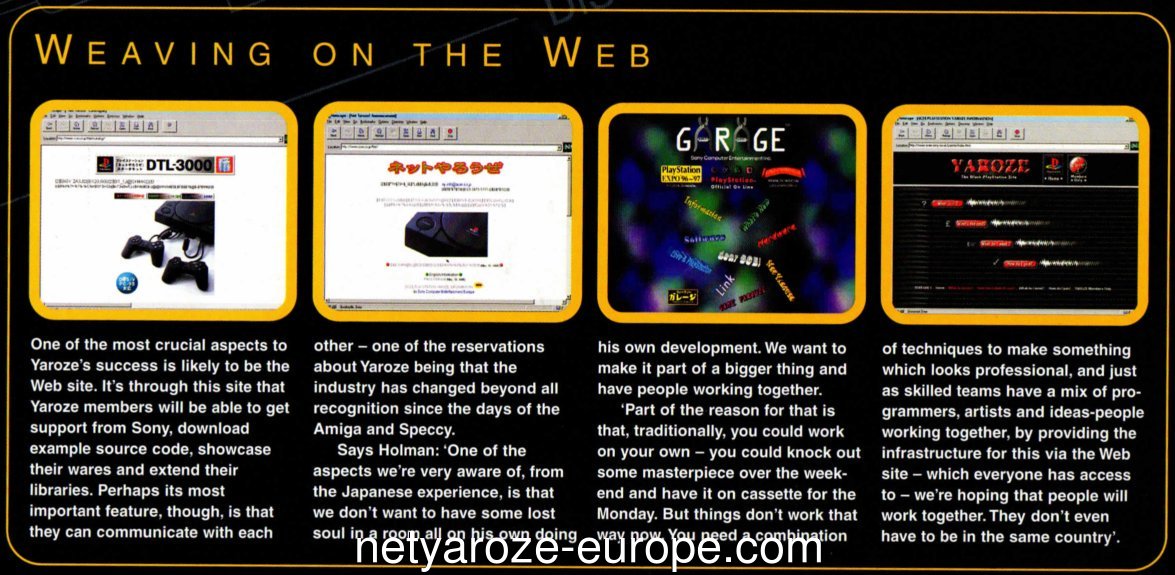
One of the most crucial aspects to Yaroze's success is likely to be the Web site. It's through this site that Yaroze members will be able to get support from Sony, download example source code, showcase their wares and extend their libraries. Perhaps its most important feature, though, is that they can communicate with each other - one of the reservations about Yaroze being that the industry has changed beyond all recognition since the days of the Amiga and Speccy.
Says Holman: 'One of the aspects we're very aware of, from the Japanese ехрепепсе, is that we don't want to have some lost soul in a room all on his own doing his own development. We want to make it part of a bigger thing and have people working together'.
'Part of the reason for that is that, traditionally, you could work on your own - you could knock out some masterpiece over the weekend and have it on cassette for the Monday. But things don't work that way now. You need a combination of techniques to make something which looks professional, and just as skilled teams have a mix of programmers, artists and ideas-people working together, by providing the infrastructure for this via the Web site = which everyone has access to - we're hoping that people will work together. They don't even have to be in the same country'.
THERE ARE NO COPYRIGHT AGREEMENTS ON YAROZE...
Once something's been written, It's for the coder to decide what to do with it.
Part of the kit you will be supplied with will include CDs and memory cards, allowing you to access the information required for programming.
To 'C' Or Not To 'C'.
Just to show you what you're up against, this is the main loop of some of Sony's sample code for a simple 2D Breakout-style game.
This loop is executed between 60 and 50 times per second (depending on whether it's running NTSC or PAL):
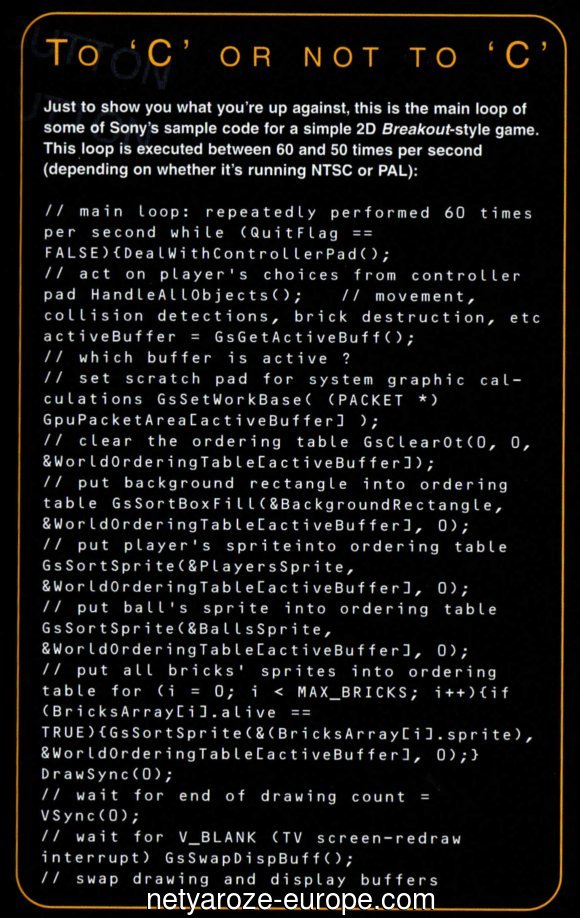
<code>
// Coded by L.Evans 25/09/96
// main loop: repeatedly performed 60 times per second
while (QuitFlag == FALSE)
{
// act on player's choices from controller
DealWithControllerPad();
// movement, collision detections, brick destruction, etc
HandleAllObjects();
// which buffer is active?
activeBuffer = GsGetActiveBuff();
// set scratch pad for system graphic calculations
GsSetWorkBase( (PACKET *) GpuPacketArea[activeBuffer] );
// clear the ordering table
GsClearOt(0, 0, &WorldOrderingTable[activeBuffer]);
// put background rectangle into ordering table
GsSortBoxFill(&BackgroundRectangle, &WorldOrderingTable[activeBuffer], 0);
// put player's sprite into ordering table
GsSortSprite(&PlayersSprite, &WorldOrderingTable[activeBuffer], 0);
// put ball's sprite into ordering table
GsSortSprite(&BallsSprite, &WorldOrderingTable[activeBuffer], 0);
// put all bricks' sprites into ordering table
for(i = 0; i < MAX_BRICKS; i++)
{
if(BricksArray[i].alive == TRUE)
{
GsSortSprite(&(BricksArray[i].sprite),&WorldOrderingTable[activeBuffer], 0);
}
}
// wait for end of drawing
DrawSync(0);
// wait for V_BLANK (TV screen-redraw interrupt)
count = VSync(0);
// swap drawing and display buffers
GsSwapDispBuff();
</code>
Things to come.
As yet nothing else is on offer, though the Japanese scheme has already done a deal with the company behind Lightwave to provide their software free to all members. According to Holman, as this is a non-profit making project, if it expands beyond expectations then the European branch can start doing the same thing and channel the revenue into free or heavily discounted software. In the meantime there are a few applications on the market which might be worth looking at. £300 will buy you a copy of Metrowerks' CodeWarrior for PlayStation and give you a slightly friendlier development environment. Adobe's PhotoShop could come in useful too, for graphics manipulation, as could a low-end 3D application. But there are plenty of good shareware programs that should provide you with at least some of the functionality you might otherwise have to pay through the nose for.
Source.
Official UK PlayStation Magazine, issue 17. March 1997, Page 68. Net Yaroze article scanned by Mike Garcia and is available in PDF form.
« Hyper Magazine - Prepare to meet your maker. Next Gen 25-Videogame school and build a better game »
Comments are open.
1 comments on "UK OPSM - Introducing PlayStation Yaroze"
http://www.netyaroze-europe.com/~lewis_e